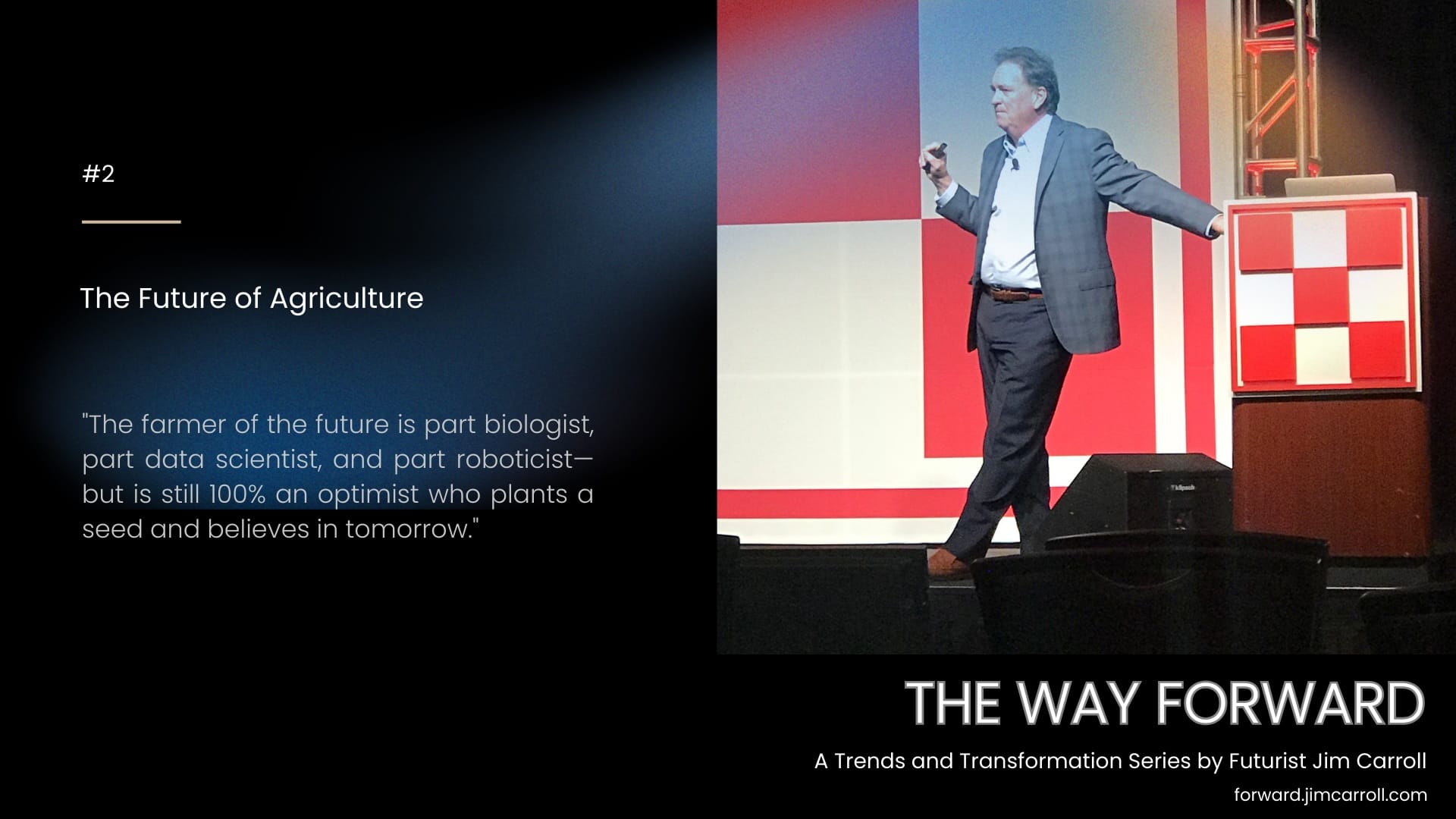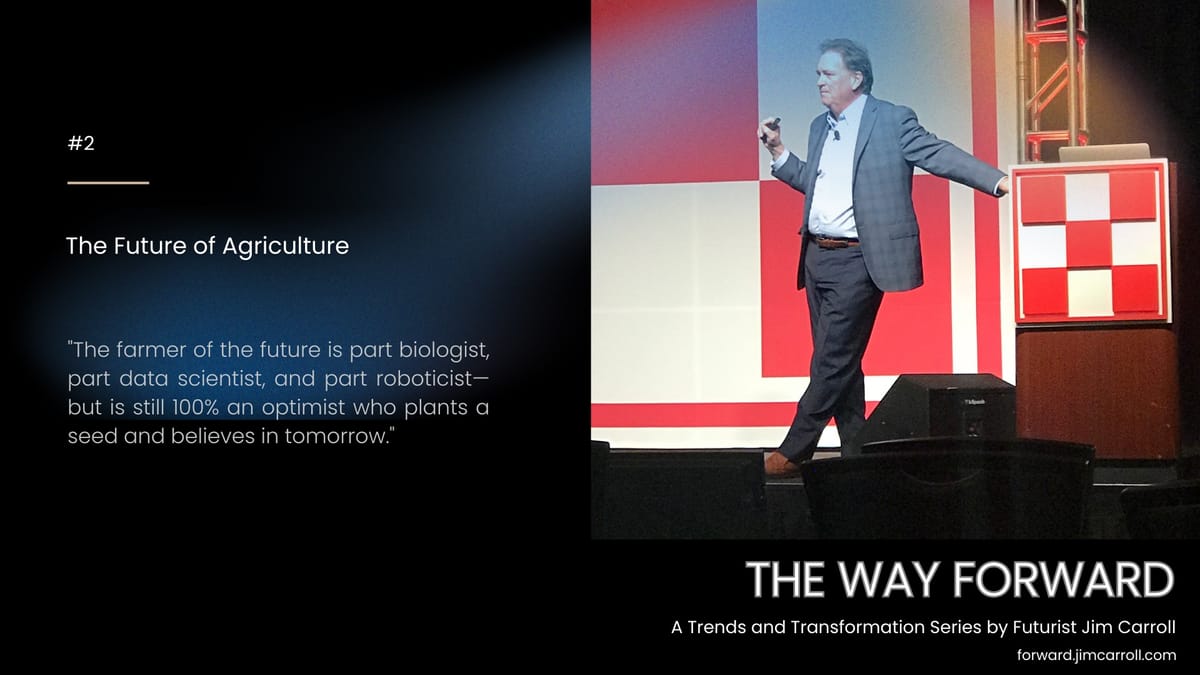"The farmer of the future is part biologist, part data scientist, and part roboticist—but is still 100% an optimist who plants a seed and believes in tomorrow." - Futurist Jim Carroll

In 2025, the headwinds are severe, and the path forward seems shrouded in fog. We’re living through one of the most volatile and unpredictable periods in recent memory. With that being the case, I am writing this new series, The Way Forward: A Trends and Transformation Series, taking a look at the trends redefining industries, and actionable strategies organizations must pursue to align to these realities. The entire series will be found at forward.jimcarroll.com
This quote captures the essence of the modern agricultural professional! Read it again: everything you need to know is right here:
"The farmer of the future is part biologist, part data scientist, and part roboticist—but is still 100% an optimist who plants a seed and believes in tomorrow."
The fact is, the sepia-toned image of a world-weary farmer with a pitchfork is a relic. Today’s farmers and ranchers are some of the most innovative people I know, operating at the intersection of advanced science, high technology, and profound optimism. They are astute business people who thrive on the complexity of their industry and are relentlessly focused on the opportunity that lies ahead. Albeit, they might make some odd choices at times!
Remember my story about the two types of farmers? If not, revisit it here. Watch the video. This is what it's all about!
With that in mind, this summary is about the second type of farmer and provides a roadmap for that future-positive farmer. Let's look at the key trends reshaping the industry, take a deeper dive into their impact, and then share an actionable playbook of ten strategies to navigate the era of acceleration and own the future of the world's oldest—and most innovative—profession.
The Landscape: 10 Trends Redefining Agriculture
To succeed tomorrow as a farmer today, you must understand the powerful forces reshaping your world. These trends are not distant possibilities; they are active realities creating massive opportunities.
- AI-Driven Precision Agriculture. AI analyzes data from drones, sensors, and satellites to create precise maps, allowing farmers to optimize the use of irrigation, fertilizer, and pesticides, which boosts yields while reducing costs and environmental impact.
- Autonomous Operations & 24-Hour Farming. The future of farming is happening faster than you think, with driverless tractors and weed-zapping robots becoming a reality. This technology is transitioning us to a world of 24-hour farming, where autonomous equipment can operate around the clock. This dramatically increases efficiency and helps to mitigate the impact of labor shortages.
- Accelerated Agricultural Science & Genomics. Agriculture is fundamentally about science, and science is accelerating at an exponential rate. Advances in genomics, nanotechnology, and bioinformatics are transforming the industry. This allows for the development of new seed varietals engineered for specific microclimates and the discovery of new uses for crops, like using soybeans as a material in car seat cushions—creating entirely new markets.
- Hyper-Connectivity & Livestock Monitoring. We are firmly in the era of the "connected cow," with "Fitbits for cows" providing a constant stream of data. These AI-powered sensors and rumination collars monitor livestock for health and welfare, providing early alerts for illness, optimizing breeding cycles, and even sending out calving alerts. This saves farmers time and money while improving overall herd management.
- Vertical Farming & Controlled Environment Agriculture (CEA). As the global population grows and arable land shrinks, farming is moving indoors. Vertical farms can reduce land use by up to 99% and water use by 95% while enabling year-round, 24-hour production in urban centers. This radically shortens supply chains, reduces transportation costs, and provides consumers with fresher produce.
- Data-Driven Decision Making. The modern farm generates a massive amount of data. AI and predictive analytics can process this data to forecast crop yields, detect plant diseases from drone imagery, monitor soil quality, and provide insights on commodity market trends, helping farmers make smarter, more profitable decisions.
- Generational Transformation. The tech-savvy "iPod generation" is taking over the family farm. These digital natives have grown up with technology and are more open to adopting new ideas and tools, from iPad-based farm management to precision ag technologies. This generational shift will ensure we see more change on the farm in the next 10 years than we have in the last 50.
- The Rise of "Just-in-Time Knowledge". The pace of change and scientific discovery has made it impossible for any single person to be an expert in everything. This has led to the emergence of specialized "knowledge partners," like manure managers or data analysts, who help farmers navigate complexity. Success now comes from the ability to get the right knowledge at the right time for the right purpose.
- Sustainability & Food Security. A core challenge is that global food production must double in the next 30 years with little new arable land available. This positions innovative and efficient growers for immense success. Furthermore, sustainability is becoming a key market differentiator, allowing producers to market products like"environmental beef" based on independently audited environmental management systems.
- Supply Chain Disruption & E-commerce. The agricultural supply chain is being reshaped by everything from global trade volatility to new technologies like blockchain for food safety and traceability. E-commerce and social media are enabling more direct consumer-producer relationships, allowing farmers to bypass traditional middlemen, build their own brand, and capture more value.
These aren't crazy, science-fiction-like ideas - these are real trends happening now!
A Deeper Dive: The Forces Reshaping the Farm
All of these trends involve a powerful convergence of digital, mechanical, and biological innovations. Here is a more detailed look at the foundational shifts underway.
The Digital Field – Precision, AI, and Data-Driven Agriculture
The most profound shift in modern farming is the transition from managing by averages to managing by specifics.
This deeper level view is provided by remote sensing from satellites and drones, which scan vast acreages to monitor crop health and identify stress long before it's visible to the naked eye. Complementing this is the micro-level detail from on-the-ground Internet of Things (IoT) devices providing a constant stream of granular data on soil moisture, nutrient levels, and localized weather.
The true transformation occurs when this data is processed by the role of AI and machine learning. Beyond prediction, AI delivers prescriptive actions: What should we do now? In California's water-scarce Central Valley, AI-powered precision irrigation systems have achieved water savings of up to 30% without sacrificing yield. In India, the agritech startup CropIn has used AI to help farmers reduce pesticide applications by 30% while increasing yields by up to 20%.There are countless other stories like this.
The Automated Farm – Robotics and the Future of Labor
As the digital revolution provides the "brains," a parallel robotics revolution is providing the "brawn."
The fully autonomous tractor has moved from science fiction to commercial reality, capable of executing complex tasks like planting and tilling 24/7 without a human operator. Companies like John Deere now offer factory-installed "Autonomy Ready" packages, while innovators like Raven Industries offer modular systems like OMNiDRIVE. The impact is profound; one of my research articles noted an 8,000-acre farmer who reports that autonomy has not only boosted efficiency but has also profoundly improved quality of life, enabling the farm to "get our time, health, and sanity back" by running operations overnight.
This technology enables a strategic shift from the "Goliath" model of ever-larger machines to a "swarm" model, where a single operator supervises a fleet of smaller, lighter autonomous robots. This reduces soil compaction and adds operational redundancy. Specialized robots are also targeting labor-intensive tasks. Robotic weeders like BoniRob use computer vision to distinguish crops from weeds and mechanically remove the latter, drastically reducing the need for herbicides and making large-scale organic farming economically viable.
The Genetic Revolution – Biology as a Core Competency
Advancements in genomics are giving farmers an unprecedented ability to enhance the biological potential of their crops and livestock.
Genomic selection has transformed breeding from an art into a science of prediction, allowing breeders to analyze an animal's DNA at a young age to calculate its future performance. Beyond reading the genetic code, new technologies like CRISPR gene editing are about writing it.
This technology is being used to create disease-resistant crops, heat-tolerant cattle, and produce with enhanced nutritional profiles and longer shelf life, building resilience directly into the genome. A landmark success story is "Sub1" rice, which was bred to tolerate flooding and now prevents the loss of an estimated four million tons of rice annually—enough to feed 30 million people!
The Evolving Business of Farming – Beyond the Commodity Model
Last but not least, many farmers are realizing the path forward is not just selling crops - it's selling value-added 'things.' The most successful agricultural enterprises are moving beyond the high-volume, low-margin model of pure commodity production, aka cash crops, where their future is determined by market prices and global volatility, i.e., tariffs. They are diversifying through three key avenues:
- Value-Added Agriculture: This is the process of transforming a raw product into something new, like turning milk into artisan cheese or apples into cider. This is a direct strategy for farmers to claim a piece of the 79% of the retail food dollar that is captured in processing, marketing, and distribution.
- Controlled Environment Agriculture (CEA): By moving production indoors into vertical farms, CEA uses technologies like hydroponics and LED lighting to grow crops year-round with up to 98% less water and 99% less land. Business models range from Infarm's in-store modular units to PlantLab's large, centralized food factories.
- Agritourism: This model links agriculture with tourism by offering on-farm experiences like "U-pick" operations, direct-to-consumer relationships built through the Web and social media,farm-to-table dinners, and educational workshops, creating a powerful direct-to-consumer revenue stream.
Bridging the Digital Furrow: An Actionable Guide for the Modern Farm
Bring it all together, and the agricultural sector is experiencing a technological transformation as profound as the mechanical revolution that defined the last century. It ain't your grandad's farm! And yet, many small and medium-sized farms (SMEs), the bedrock of rural economies, are struggling to keep pace, facing a formidable set of financial, infrastructural, and educational barriers.
What's in the way? The path to adopting these transformative technologies is often blocked by a consistent set of challenges - money, skills, and often, fear!
- Financial Hurdles: The high initial capital cost of advanced machinery like autonomous tractors or robotic weeders, combined with an unclear or long-term Return on Investment (ROI), remains a primary barrier for operators with tight margins.
- Skills and Knowledge Gaps: The complexity of modern AgTech creates a significant skills gap. There is a shortage of workers with the expertise to operate, manage, and maintain these new systems, from data analytics to robotics maintenance.
- Infrastructural Deficits: A lack of reliable, high-speed internet connectivity in many rural areas is a fundamental obstacle to leveraging cloud-based farm management platforms, IoT sensors, and other data-intensive technologies.
- Data & Security Concerns: As farms become more connected, issues of data ownership, privacy, and cybersecurity become critical. Many farmers are rightly concerned about who controls their operational data and how it is being used by technology providers. Efforts by equipment providers in advanced technology have led to the 'right-to-repair' movement - many farmers are pretty pissed off at organizations like John Deere which have locked down smart equipment with onerous policies!
Beating the Odds: Case Studies in Agricultural Transformation
Even so, despite these barriers, "future-positive" farmers are proving that transformation is possible. I dug out a few success stories that provide a powerful blueprint; I've shared many more from the stage over the years.
- The ROI of Autonomy (Betsy Rowland's Farm): On her 8,000-acre corn and soybean farm, the deployment of autonomous tractors has done more than just boost efficiency by allowing labor to be reassigned to higher-value tasks. It has profoundly improved her quality of life, enabling the farm to run operations overnight while she sleeps, helping her "get our time, health, and sanity back."
- The Power of Specialized Robotics (BoniRob): To combat rising herbicide resistance and meet consumer demand for organic produce, robotic weeders like BoniRob use advanced computer vision to identify and mechanically remove weeds with precision. An Austrian farmer using a similar system reported removing 70% of weeds with zero hours of manual labor, a task that previously took 180 person-hours per hectare, making large-scale organic farming economically viable.
- The Impact of Advanced Science (Sub1 Rice): Researchers identified a gene that conferred remarkable tolerance to flooding and, using Marker-Assisted Selection, precisely bred it into popular high-yielding rice varieties. The resulting Sub1 rice now prevents the loss of an estimated four million tons of rice annually—enough to feed 30 million people—demonstrating how targeted genetic innovation can build global resilience.
The Playbook: 10 Actionable Strategies for the Future-Positive Farmer
So what should a modern, future-oriented farmer do?
Knowing the trends is not enough. The future belongs to those who act.
Here is a playbook of ten actionable strategies I have covered on stage for agricultural leaders around the world.
- Master the Data to Master the Farm: Your farm's most valuable asset is shifting from physical inventory to information capital. Conduct a data audit to see what you're already collecting, define the data most critical to your profitability, and start with a single, high-impact data project (like using soil sensors in one field) to prove ROI before scaling.
- Embrace "Autonomy as a Service": The future can seem like a big investment - and it is! De-risk the high capital cost of taking a different approach - for example, with robotics, shift your mindset from ownership to access. Explore equipment leasing, "AgTech-as-a-Service" subscription models, or hire custom work providers who have already invested in the latest autonomous equipment. Consider retrofitting existing tractors with aftermarket autonomy kits to lower the barrier to entry. Find a local kid who is into robotics - and bring them onto the farm as an apprentice!
- Architect Your Value Chain: Move up the food chain by identifying a defensible niche for a value-added product, such as artisan cheese or specialty flour. Map out the venture, start small by selling at farmers' markets to test demand, and leverage your farm's unique story as a key marketing asset to build a powerful brand.
- Leverage Genetic Insights for Competitive Advantage: The industry is surrounded by 'agricultural coaches' - work with them! Find genetic consultants or breeding cooperatives to help you define your genetic goals and implement a strategic genotyping plan. Integrate this genomic data into day-to-day management decisions to accelerate the rate of genetic improvement and ensure you are investing the most resources in the animals and crops with the highest potential.
- Build a Collaborative Ecosystem: The complexity of modern agriculture is too great to master alone. Forge strategic partnerships with academic institutions for early access to research, hire specialized consultants for targeted challenges like data management, and form peer-to-peer learning networks with other innovative farmers to shorten the learning curve.
- Design for Resilience, Not Just Yield: View sustainability as an economic driver. Adopt practices like cover cropping and reduced tillage that improve soil health, which in turn reduces input costs and makes your operation more resilient to climate volatility. Explore circular economy principles, such as using an anaerobic digester to turn manure into a value stream (biogas and fertilizer).
- Invest in Human Capital: Treat investment in your team's skills with the same seriousness as investment in machinery. Conduct a skills inventory to identify gaps, budget for continuous training, and empower a "tech champion" within your team to lead the adoption of new tools. Prioritize technologies with intuitive user interfaces and strong customer support to reduce the training burden. Find the young people who get it!
- Pilot, Prove, and Propagate: Use a disciplined, evidence-based approach to technology adoption. Start with a small-scale pilot project on a single field or group of animals. Define your success metrics upfront and rigorously track the data to prove the ROI. If the pilot is successful, use the lessons learned to inform a phased, strategic rollout across the rest of your operation.
The agricultural landscape is in the midst of its most profound transformation in a century.
The future of farming is not a singular choice between technology, biology, or business strategy; success lies in their masterful integration. The modern farmer must be conversant in the language of data analytics, fluent in the principles of genetic potential, and skilled in the art of strategic enterprise. While the tools of the farmer are undergoing a radical evolution, the fundamental spirit of the profession remains constant. It is a spirit rooted in a profound optimism—the unwavering belief that investing labor, capital, and intellect into the soil today will yield a harvest tomorrow.
The future-positive farmer embraces this duality. They are the data scientist analyzing satellite imagery, the roboticist dispatching autonomous machines, and the biologist selecting a seed with genetically encoded resilience.
But at their core, they are still the optimist who, in deploying that seed, places a fundamental bet on the future. It is this potent combination of high-tech innovation and timeless optimism that will not only secure the future of the individual farm but will cultivate the future of the global food system itself.

